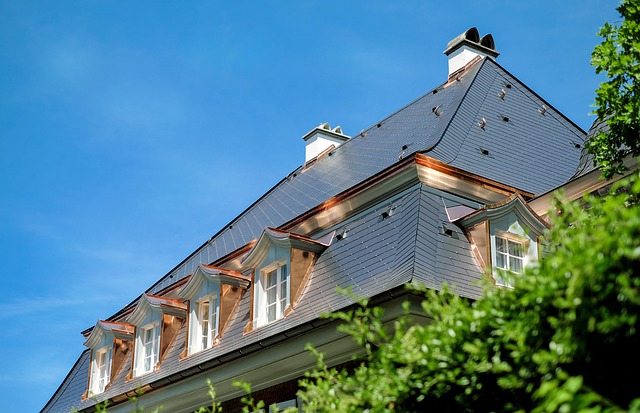Green roofs are a revolutionary concept in architecture, offering multiple environmental benefits like heat management, air pollution reduction, and water conservation. With advancements in materials and technology, modern sustainable roof systems provide enhanced insulation, improved air quality, and increased biodiversity. Integrating solar panels and permeable membranes further expands their functionality, transforming urban spaces into greener, healthier habitats. Future trends include tailored renewable energy solutions, efficient water management, lightweight growing media, and IoT-enabled monitoring for optimal resource use.
“Discover the future of sustainable roofing with innovative green roof technology. This article explores the eco-friendly revolution known as green roofs, highlighting cutting-edge materials transforming urban and remote locations alike. From environmental benefits to diverse applications, we delve into how these advanced systems are redefining sustainability. Expect insights on the latest trends and innovations shaping the future of green roofs, offering a glimpse into a greener, more resilient tomorrow.”
- Understanding Green Roofs: The Eco-Friendly Revolution
- Cutting-Edge Materials Shaping Sustainable Roof Systems
- Benefits and Applications: From Urban to Remote Locations
- Future Trends and Innovations in Green Roof Technology
Understanding Green Roofs: The Eco-Friendly Revolution
Green roofs are a revolutionary concept in sustainable roofing, offering an eco-friendly alternative to traditional systems. This innovative approach involves planting and growing vegetation on top of buildings, transforming rooftops into vibrant green spaces. Beyond aesthetics, green roofs provide numerous environmental benefits, making them a smart choice for modern architecture.
As urban areas continue to expand, the need for sustainable roof systems has become increasingly important. Green roofs help mitigate the urban heat island effect, improve air quality, and reduce the strain on municipal water supplies by minimizing stormwater runoff. They also contribute to biodiversity, providing habitats for local wildlife, and can significantly extend the lifespan of a building’s roofing system.
Cutting-Edge Materials Shaping Sustainable Roof Systems
The future of green roofs is here, thanks to cutting-edge materials that are transforming sustainable roof systems into multi-functional landscapes. Gone are the days when lightweight growing media and mats were the primary components. Today, innovative technologies offer a range of options, from self-watering systems that reduce maintenance needs to advanced composite materials that mimic traditional roofing while providing superior insulation and air quality benefits. These materials not only enhance aesthetic appeal but also contribute to energy efficiency, storm water management, and biodiversity.
From solar panels integrated into roof systems to permeable membranes that allow for effective drainage while supporting plant growth, the possibilities are vast. This evolution in design encourages a holistic approach to architecture, where buildings become living organisms that interact harmoniously with their environment. As these sustainable roof systems gain popularity, we can expect even more breakthroughs, making urban spaces greener, healthier, and more sustainable for future generations.
Benefits and Applications: From Urban to Remote Locations
Green roofs, or sustainable roof systems, offer a wide array of benefits and have diverse applications across various landscapes, from urban centres to remote areas. One of their primary advantages is environmental sustainability; these roofs help mitigate the urban heat island effect, reduce stormwater runoff, and provide insulation, leading to energy-efficient buildings. They also contribute to biodiversity by creating habitats for local flora and fauna, enhancing ecosystem resilience.
In urban settings, green roofs are transforming skyscrapers into eco-friendly oases, improving air quality and providing recreational spaces. Remote locations, such as research stations or off-grid communities, can utilize these systems for water harvesting, food production, and creating resilient living environments. With innovative materials like lightweight growing mediums, hydroponic systems, and drought-resistant plants, green roofs are no longer limited to low-slope areas; they can now be implemented in various settings, contributing to a greener and more sustainable future.
Future Trends and Innovations in Green Roof Technology
The future of green roofs is brimming with innovation, driven by a growing demand for sustainable solutions in urban environments. Emerging trends showcase a shift towards more integrated and intelligent systems. One such development is the incorporation of renewable energy sources, like solar panels, seamlessly incorporated into roofing structures, offering not only environmental benefits but also enhancing building aesthetics. As technology advances, we can expect to see even more sophisticated water management systems that efficiently collect and utilize rainwater, contributing to drought mitigation and reducing strain on municipal water supplies.
Another promising area of focus is the evolution of growing media. Researchers are exploring lightweight, eco-friendly alternatives to traditional soil, such as aeroponics and hydroponics, which enable faster plant growth and reduced water usage. These innovations promise to make green roofs more accessible and cost-effective while maintaining their ecological advantages. Additionally, the integration of smart sensors and IoT (Internet of Things) technology allows for real-time monitoring of roof performance, optimizing resource use, and enabling predictive maintenance, further solidifying the role of green roofs as essential components of sustainable urban infrastructure.
Green roofs are no longer a futuristic concept; they are an eco-friendly reality, reshaping urban landscapes and offering numerous benefits for both built-up areas and remote locations. With innovative materials pushing the boundaries of what’s possible, the future of sustainable roof systems looks bright. As we continue to navigate environmental challenges, embracing these cutting-edge technologies will be key to creating a greener, more resilient world. Let’s dive into the exciting possibilities that lie ahead in this growing field.
